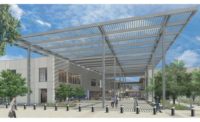Why do historic buildings and other unexpected structures make such great settings for hotels and restaurants? Join Hall-of-Fame interior designer Nancy Ruddy with an all-star panel to discuss these “Stunning Second Acts” in New York at 2:30pm on Monday, November 13th.
Ruddy, whose design debuted last month for Sugarcane Raw Bar Grill in the historic Empire Stores building, a Civil War-era landmark in Brooklyn’s Dumbo neighborhood, will lead the afternoon panel at the annual Boutique Design New York trade fair, known as BDNY, held at Javits Convention Center.
Adaptive reuse for hospitality projects is a growing trend among owners, operators, and their design teams. From regulatory questions to boosting market appeal and the bottom line, key players discuss best practices and the issues architects and designers need to understand to help clients succeed.
CEU credits available for this program for both IDCEC and AIA registrants.
Attendees will hear how building codes and health codes impact hospitality properties in the context of adaptive reuse projects. Development incentives and tax credits available through public agencies for a given original building type are described, with representative adaptive reuse projects showing how historic preservation requirements and permitting issues affect the conversion to hospitality uses such as hotels and restaurants. Other topics discussed include design goals and budget limitations, brand and program elements, materials and construction methods, as well as owner operational goals.
MODERATOR
Nancy Ruddy, co-founder, CetraRuddy
PANELISTS
Frank Fortino, chief operating officer, Metropolis Group, Inc.
Lauren Rottet, founding principal and president, Rottet Studio
Mark Gordon, managing principal, Instrinsic Hotel Capital
Michael Overington, vice chairman and president, Ian Schrager Co.
The group will discuss why adaptive reuse is a growing trend for hospitality projects and often highly attractive to owner/operators. They will also tackle a few of the thornier issues such as zoning and codes challenges, methods for boosting market appeal, and bottom-line challenges.



